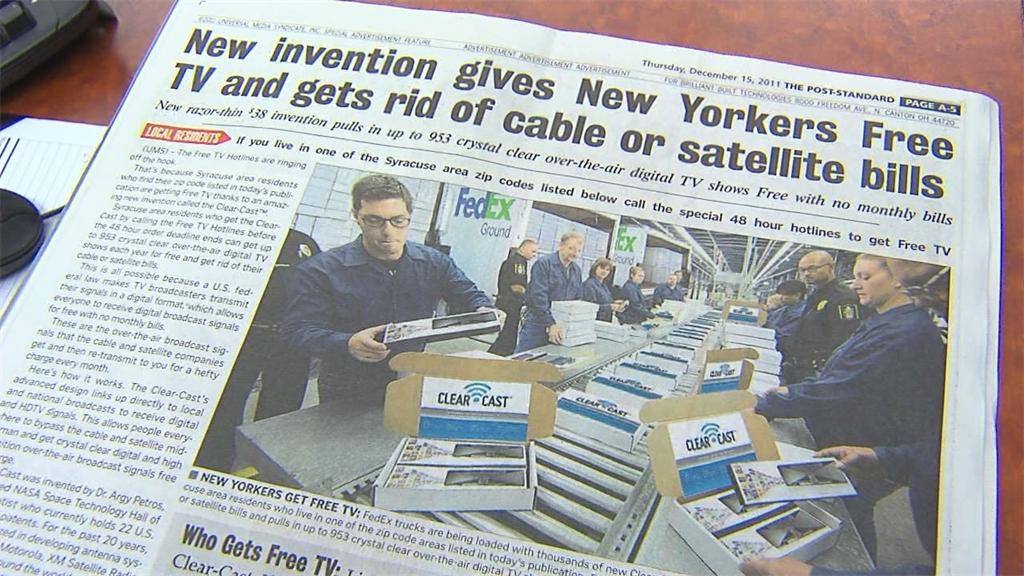
An ad in the Syracuse Post-Standard announces a new invention -- a variation on the bow tie antenna design originally designed in the 1950s.
Last Thursday, Syracuse newspaper readers were treated to news of an impressive breakthrough that promises to deliver salvation from high cable and satellite TV bills forever.
Clear Cast, a “razor thin” indoor digital HDTV antenna lets you watch television… for free.
The product is shown being packaged up for shipping while an impatient-looking FedEx driver tries to coordinate the apparent extraordinary demand for a downright revolutionary development in television engineering.
Local residents called the newspaper and other local news outlets to try and learn more about the curious new device.
Stop the Cap! can now report the revolution can be postponed.
In fact, the published account about the “new invention” was actually a paid advertisement-designed-to-look-like-a-news-story. Clear Cast is effectively a variation on the traditional indoor UHF bow tie antenna your local Radio Shack used to sell for $1.49. The major difference is that it is designed to be attached to a window with accompanying suction cups. That is a valid approach to improving reception, but whether it is worth the asking price of $38 is another matter.
As consumers seek alternatives to higher cable and satellite TV bills, overhyped ad copy promising freedom from high bills cannot be far behind. Repackaging basic antennas that were part of our lives from the 1950s-on can go too far when leaving some residents with the impression they are getting more than a basic television antenna.
In fact, over-the-air viewing can be easily accomplished in strong signal areas with the cheapest antenna, as long as it is designed for both VHF and UHF reception. Many VHF stations with channel numbers from 2-13 quietly relocated to the UHF dial, but still advertise their original channel numbers. If your television is not equipped with a UHF antenna, reception may be difficult.
For the benefit of those under the age of 40: most televisions used to come equipped with both antenna designs — two elongated antenna rods some used to call “rabbit ears” and an accompanying round loop antenna, or often a bow tie design that clipped to one of the two longer aerials. The long straight antennas are designed for VHF signals, the bow tie or loop design accommodated improved UHF reception.
Over the last decade, marketing has attempted to revolutionize what remains basic, sober, antenna design — with an accompanying “revolutionary” price tag. When satellite television was first introduced, some manufacturers redesigned set top aerials to look like a satellite dish and then pitched them as “saving you the high price of satellite TV because it is not satellite!” In today’s HD-ready era, marketers have done it again.
Will Clear Cast work? Undoubtedly, but probably not much better than any other traditional bow tie design that costs $35 less.
If you are cutting cable’s cord and want to rely on over-the-air television, our best advice is to start with something inexpensive and upgrade only when necessary. In urban and suburban areas, an effective indoor antenna can cost less than $5. Try repositioning it until you find the best spot to receive the most channels with the least signal reception errors. Directional indoor antennas can offer mild signal improvement, especially in areas where adjacent signals from nearby cities create reception problems. Because the American digital broadcast standard is frankly less robust than the European counterpart, those in more distant suburbs or rural areas will really need to invest in a rooftop antenna to enjoy consistent reception. A potential compromise would be to mount an outdoor antenna in the attic.
Avoid “futuristic” designs and powered indoor antennas and read consumer reviews carefully. We’ve found most indoor antennas priced above $35 to be more hype than performance-per-dollar. If you need an outdoor antenna, check your local Yellow Pages for antenna specialists who understand local reception conditions and can recommend high quality, long lasting antennas that will work for the stations you want to receive.
[flv width=”480″ height=”290″]http://www.phillipdampier.com/video/WSYR Syracuse Newspaper ad for free TV The Real Deal 12-15-11.mp4[/flv]
WSYR in Syracuse investigates the ‘revolutionary’ new indoor TV antenna that is so popular, only residents in certain zip codes can order it. (2 minutes)


 Subscribe
Subscribe




